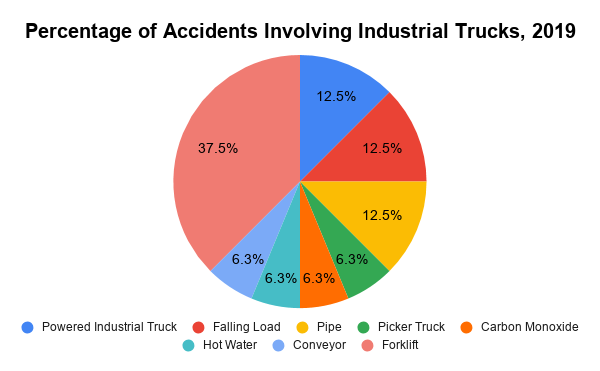With 73% of companies expecting to have automation technologies adopted within the next 5 years, there is little question that the steady growth of AI-driven automation in the workplace is having a profound impact on industries. Yet one topic that is not always front of mind when we consider these changes is the effect increased automation is having on workplace health and safety.
The Impact of Automation on Workplace Health and Safety
Many companies see automation as having an overwhelmingly positive impact on workplace health and safety in the processing, materials handling and logistics sectors, largely because of its ability to minimize workplace injuries. Specifically, autonomous robots can tackle dull, dangerous, and repetitive tasks. Automation has a direct impact on reducing three of the top five causes of occupational injury — contact with objects (i.e. injuries caused by people operating machines), overexertion (i.e. lifting heavy loads) and repetitive stress injuries. Between them, these three account for nearly three-quarters of all workplace injuries in the US. In the materials handling sector, the use of manually-operated forklifts results in 85 fatalities and 34,900 serious injuries each year.

Graph 1: Over 37% of accidents involving industrial trucks were caused by forklifts.
By replacing manually-driven forklifts with autonomous robots, accident rates can be reduced and lives can be saved. For example, OTTO Motors worked with window and door manufacturer Sunview Patio Doors to replace the tow motors and forklifts the company used to transport finished products from the end of its production line to its warehouse with OTTO Autonomous Mobile Robots (AMRs). The safety benefits experienced by the company are unprecedented.
It’s the first type of material handling equipment that has a 100% safety rate, we haven’t had a single incident and it’s been over a year.
— Kurt Oberparleiter, VP of Operations, Sunview Patio Doors
How to Prioritize Health And Safety Around Robotics
Despite case studies showing the safety benefits of automation, like Sunview, there are still those who are more cautious and concerned about the potential impact of robotics and AI-driven automation on workplace health and safety. They argue that while automated solutions are increasingly able to take on higher-risk tasks in factories and warehouses, growing adoption of robotics is also putting people in contact with more and more potentially dangerous machinery in the workplace. That, some argue, is enough to present new health and safety challenges. So, how can those that are worried about robotics and automation come to trust the technologies from a health and safety perspective?
For one, it is important to understand the many benefits of automation, beyond just health and safety. Health and safety compliance processes are themselves pretty labor intensive, requiring a lengthy cycle of repetitive inspections, form-filling and implementing improvements. Therefore, mistakes and oversights frequently creep in. AI is already well capable of carrying out safety checks and risk assessments with far greater efficiency and accuracy than people can, allowing those employees to work on other, more interesting and value-added tasks.
If a job is repetitive and boring, human workers tend to make a mistake, whereas robots can do these things the same way time after time.
— Frank Hearl, Chief of Staff, The National Institute for Occupational Safety and Health

Chart 2: From 2016 to 2030, less hours will be spent on tasks that require physical and manual skills, as well as basic cognitive skills, but more hours will be spent on tasks requiring higher cognitive skills, social and emotional skills, and technological skills.
From computer vision platforms that carry out visual inspections via cameras to robotic process automation (RPA) tools that fill out the forms and trigger alerts when something doesn’t quite look right, AI solutions are designed to eliminate errors and complete administrative safety tasks faster than human workers.
On top of providing efficiency benefits, AI-driven equipment is actually designed to minimise risks and accidents, and the technology used to do so is increasingly sophisticated and reliable. For example, by linking sensors to AI control software, cobot and automated robot manufacturers are able to create solutions which detect and avoid human or object obstacles, quickly and autonomously finding a safer route.
Through research and viewing case studies like Sunview, companies that are worried about implementing robotics and automation in their facilities can learn to trust the technology and understand the benefits of automation in the area of worker safety.
THE SAFETY ROI FOR AUTOMATING MATERIAL MOVEMENT
Sunview Patio Doors achieves 100% safety rating and 16-month ROI with AMR technology
THE SAFETY ROI FOR AUTOMATING MATERIAL MOVEMENT
Sunview Patio Doors achieves 100% safety rating and 16-month ROI with AMR technology
